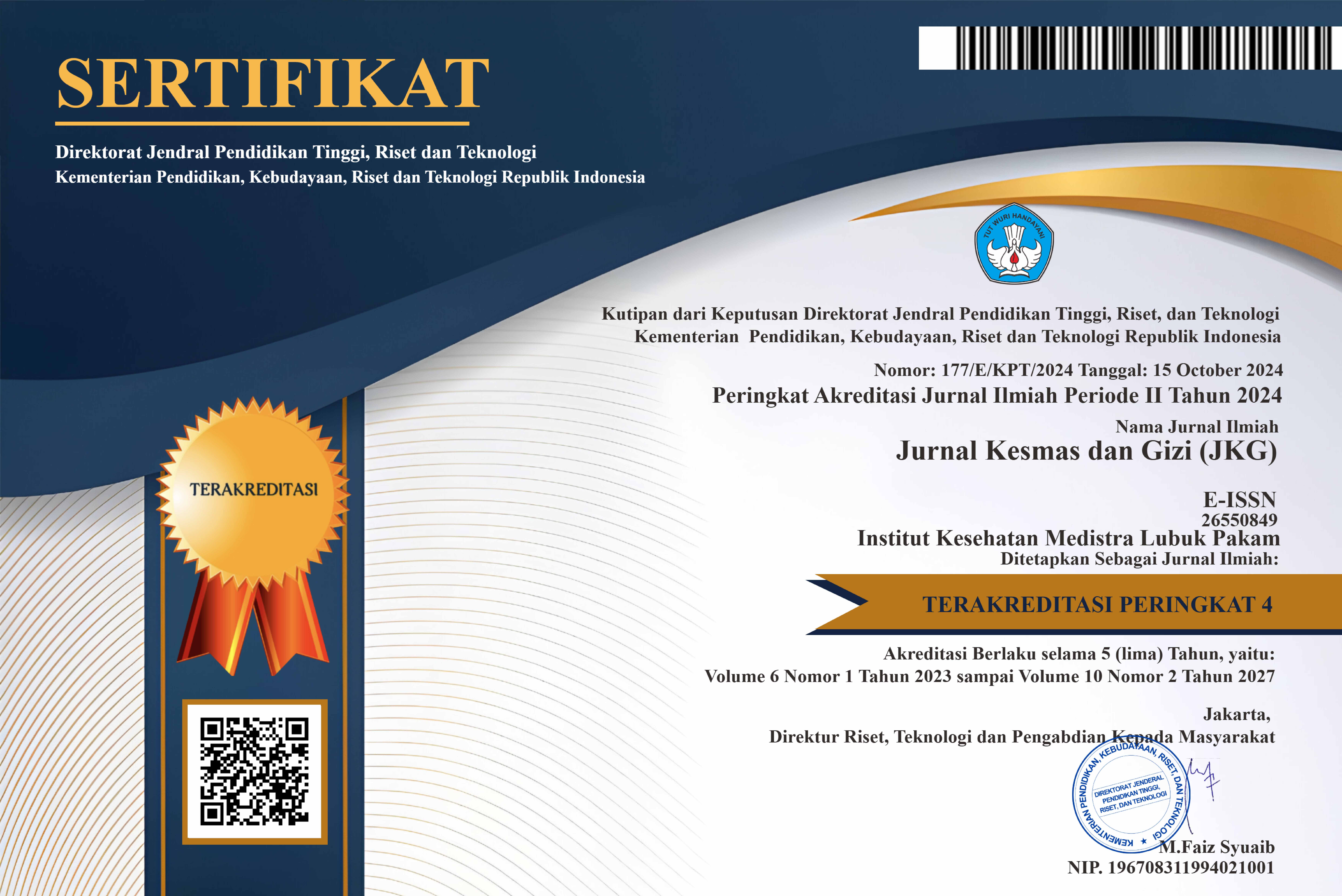Analysis of The Utilization of Posbindu Program Services For Non-Communicable Diseases (NCDS) In The Community at the M Public Health Center
DOI:
https://doi.org/10.35451/jkg.v6i2.2135Keywords:
Non-communicable Diseases, Utilization, PosbinduAbstract
Non-communicable diseases have become the main cause of death globally and nationally, due to the high number of NCDs which continue to increase every year, so to control PTM risk factors in Indonesia, the government established the Posbindu PTM program. However, the utilization of Posbindu PTM in the working area of the Brand Health Center has not reached the target of 100%. This study aims to determine the factors associated with the utilization of Posbindu PTM. This type of research is quantitative with cross-sectional design and the analysis used is univariate and bivariate. The population in this study were people suffering from non-communicable diseases in the working area of the Brand Health Center. The sample in this study amounted to 100 people. The results showed that out of 100 respondents, 60.0% used Posbindu PTM. Variables related to the utilization of Posbindu PTM were knowledge (p=0.001), mileage (p=0.011), family support (p=0.004), attitude (p=0.001), and health status (p=0.002). The variable that is not related to the utilization of Posbindu PTM is the variable support from health workers (p=0.423). It is recommended for puskesmas to further improve the quality of life of the community through collaboration with health workers such as cadres..
Downloads
References
Akbar, H. (2020). Determinan Epidemiologis Kejadian Hipertensi Pada Lansia di Wilayah Kerja Puskesmas Jatisawit. HIBUALAMO Seri Ilmu-Ilmu Alam Dan Kesehatan, 2 (2), 41–47.
Anggreani, S. 2020. Determinan Pemanfaatan Posbindu PTM di Desa Uwie Wilayah Kerja Puskesmas Muara Uya Kabupaten Tabalong. Jurnal Kesehatan Masyarakat. Volume 10, Nomor 02 ISSN 2089-0346.
Astriani, D., Duma, K. and Sihotang, F. A. (2021). Faktor Yang Mempengaruhi Pemanfaatan Pos Pembinaan Terpadu Penyakit Tidak Menular (Posbindu Ptm). JURNAL KESEHATAN STIKes MUHAMMADIYAH CIAMIS, 7(2), pp. 8–15. doi: 10.52221/jurkes.v7i2.62.
Bustan. Epidemiologi Penyakit Tidak Menular. Jakarta: Rineka Cipta, 2007.
Depkes RI. Pedoman Surveilans Penyakit Jantung dan Pembuluh Darah. Jakarta: Departemen Kesehatan RI, 2007.
Evi, F. 2021. Faktor yang memengaruhi utilitas atau pemanfaatan posbindu PTM (Pos Pembinaan Terpadu Penyakit Tidak Menular) pada Puskesmas Mompang Kec. Panyabungan Kab. Mandailing Natal. Jurnal Kesehatan Global, Vol. 4, No. 3, September 2021 : 142-151.
Fauzia, H. 2020. Pemanfaatan pos pembinaan terpadu penyakit tidak menular (posbindu ptm) oleh wanita lansia dalam rangka mencegah penyakit tidak menular di wilayah kerja puskesmas cilongok 1. Jurnal kesehatan masyarakat (e-Journal) ) (ISSN: 2356-3346).
Febriani CA, Perdana AA, Sari TD. 2021. Faktor-Faktor yang Berhubungan dengan Pemanfaatan Pos Pembinaan Terpadu Penyakit Tidak Menular. J Penelit Perawat Prof.;3(1):165–78.
Irawan B, Ainy A. Analisis Faktor-Faktor yang Berhubungan dengan Pemanfaatan Pelayanan Kesehatan pada Peserta Jaminan Kesehatan Nasional di Wilayah Kerja Puskesmas Payakabung, Kabupaten Ogan Ilir. J Ilmu Kesehat Masy. 2018;9(3):189–97.
Kementerian Kesehatan Republik Indonesia. 2014. Pedoman Umum Pos Pembinaan Terpadu Penyakit Tidak Menular.
Kementerian Kesehatan Republik Indonesia. 2018. Riset Kesehatan Dasar Tahun 2018.
Kementerian Kesehatan RI. Program P2PTM dan Indikator – Direktorat P2PTM 2019.
Kementerian Kesehatan Republik Indonesia. 2020. Profil Kesehatan Republik Indonesia Tahun 2017.
Melita, Nadjib M. Faktor-faktor yang Berhubungan dengan Kunjungan Lansia ke Posbindu Lansia di Wilayah Kerja Puskesmas Kelurahan Bintara Kota Bekasi tahun 2017. J Kebijak Kesehat Indones. 2018;07(04):158–67.
Nasruddin, Nurizka Rayhana, . 2017. Faktor-Faktor Yang Mempengaruhi Pemanfaatan Pos Pembinaan Terpadu Penyakit Tidak Menular (Posbindu PTM) Di Wilayah Kerja Puskesmas Ballaparang Kota Makassar Tahun 2017. Skripsi, Program Studi Kesehatan Masyarakat Fakultas Kedokteran dan Ilmu Kesehatan UIN Alauddin, Makassar.
Notoatmojo, S. 2010. Metodologi Penelitian Kesehatan. Jakarta: Rineka Cipta.
Notoadmojo, Soekidjo. (2018). Promosi Kesehatan dan Ilmu Perilaku. Jakart: Rineka Cipta
Puskesmas Merek. 2022. Data Register Posbindu PTM.
Rusdiyanti, Ivong. 2017. Faktor-Faktor Yang Mempengaruhi Keaktifan Kunjungan Pos Pembinaan Terpadu Penyakit Tidak Menular Di Desa (Factors That Influence The Activity Of Visited Integrated Posting Most Of Diseases In The Village). Healthy-Mu Journal, Volume 1 Nomor 2.
Rusmiati, 2021. Faktor-faktor yang berhubungan dengan pemanfaatan pos pelayanan terpadu (posbindu) penyakit tidak menular di wilayah kerja puskesmas simpang tiga kecamatan bukit kabupaten bener meriah. Journal of Healthcare Technology and Medicine Vol. 7 No. 2 e-ISSN : 2615-109X.
Shilton T., Beatriz C., & Claire B. Towards a Global Framework for Capacity Building for Non-communicable Disease Advocacy in Low and Middle Income Countries. Global Health Promotion Journal, 20 (4), 2016.
Siti, H. 2022. Faktor-faktor yang mempengaruhi pemanfaatan Posbindu PTM pada masa Pandemi COVID-19 di wilayah kerja Puskesmas Dalu Sepuluh. Skripsi. Universitas Islam Negeri Sumatera Utara.
Supriyatna E, Pertiwiwati E, Setiawan H. Faktor-Faktor Yang Mempengaruhi Pemanfaatan Posbindu Ptm Oleh Masyarakat Di Wilayah Kerja Puskesmas Martapura 2. J Publ Kesehat Masy Indones. 2020;7(1):1.
Umayana, Haniek Try dan Widya Hary Cahyati. 2015. Dukungan Keluarga Dan Tokoh Masyarakat Terhadap Keaktifan Penduduk Ke Posbindu Penyakit Tidak Menular. Jurnal ernama masyarakat, Nomor 1, : 96-101.
Undang Undang Republik Indonesia Nomor 36 Tahun 2009 Tentang Kesehatan.
WHO. Global Status report on noncommunicable Disease 2014. World Health, p.176, 2020.
Downloads
Published
Issue
Section
License
Copyright (c) 2024 Reni Aprinawaty Sirait, Riady Suranta Sinuhaji

This work is licensed under a Creative Commons Attribution 4.0 International License.
Copyright in each article is the property of the Author.


























